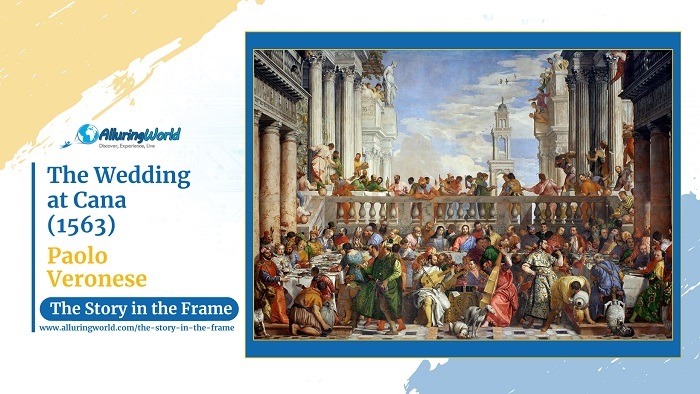Painted in 1563 for the refectory of the Benedictine monastery of San Giorgio Maggiore in Venice, The Wedding at Cana is one of the grandest and most elaborate depictions of a biblical scene in Renaissance art. This monumental oil painting, painted by Paolo Veronese, measuring an astonishing 6.77 m × 9.94 m (22.2 ft × 32.6 ft), captures the moment when Christ miraculously turns water into wine at a lavish wedding feast. Commissioned by the Benedictine monks, the painting not only illustrates divine intervention but also serves as a dazzling display of Venetian opulence, filled with rich details, vibrant colors, and a vast assembly of figures.
About the Painter:
Paolo Veronese (1528–1588) was one of the leading painters of the Venetian Renaissance, celebrated for his grand compositions, brilliant use of color, and mastery of perspective. Known for his decorative frescoes and large-scale canvases, he specialized in complex, theatrical scenes filled with aristocratic figures and classical architecture, and his ability to blend sacred themes with the elegance of Venetian life set him apart from his contemporaries. It goes without saying that his grandiose and very majestic work influenced later Baroque painters with its dynamic compositions and sophisticated use of light.
Inspiration and Reasons Behind the Painting:
The Wedding at Cana is based on the Gospel of John (2:1-11), which recounts Christ’s first miracle by transforming water into wine at a wedding in Cana, and this event that is considered as the beginning of Christ’s public ministry, was a popular subject in Christian art. However, Veronese took an unconventional approach, transforming the biblical story into a grand Venetian banquet scene as he reflected the splendor of 16th-century high society. The painting not only served a religious purpose but also showcased Venice’s wealth, cultural sophistication, and artistic excellence, aligning with the grandeur of its setting in the monastery’s dining hall.
What is Depicted in the Painting:
The vast composition features over 130 figures gathered around an enormous banquet table, placed within an architectural setting of classical columns and arches. At the center, Christ sits calmly, surrounded by the Virgin Mary, apostles, and wedding guests, as servants pour water into large stone jars, symbolizing the impending miracle. The foreground is filled with noble guests, musicians, and attendants, many of whom are dressed in extravagant Venetian attire, reflecting the fusion of biblical narrative and contemporary grandeur. Several historical and artistic figures are believed to be included, such as Titian and Tintoretto as musicians, and above, the sky is filled with birds, and the architecture creates a sense of vast openness, enhancing the painting’s monumental scale.
Colors and Techniques:
Veronese’s mastery of color is evident in the painting’s radiant palette, dominated by rich golds, deep reds, luminous blues, and soft whites. The interplay of light and shadow creates depth and realism, while the precise rendering of fabrics, jewels, and textures enhances the luxurious feel of the scene. The artist’s use of perspective and architectural framing guides the viewer’s eye toward Christ, ensuring that the spiritual significance remains at the heart of the composition despite the surrounding spectacle. The brushwork is meticulous, capturing the liveliness of gestures, facial expressions, and movement, which adds to the painting’s dynamic energy.
Conclusion:
Overall, The Wedding at Cana is not just a biblical illustration but a masterpiece of artistic innovation, blending religious themes with the magnificence of Venetian society. Its grand scale, intricate details, and vibrant colors make it one of the most impressive works of the Renaissance, and today, it remains a highlight of the Louvre Museum, where it continues to captivate audiences with its breathtaking composition and timeless narrative of divine generosity and human celebration.

